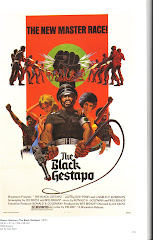By Manifesto Joe
Yesterday I was contemplating the front page of a major metro daily newspaper. Above the fold: "Less holiday cheer at most corporate parties this year" -- a short teaser piece about how cost-cutting is affecting office parties, with a "refer," as it is known in the profession, to a long story on the business cover.
Right below that, a colorful "centerpiece," as newspaper designers call it: "It's LSU against Ohio State after season of ups, downs" The centerpiece is the most prominent feature on a cover page. This one really belonged on 1D, the sports cover.
This stuff was above the fold. Below, I found a short teaser piece about how Venezuelan voters narrowly rejected constitutional changes that would have allowed President Hugo Chavez to run for re-election indefinitely.
We all have our priorities. And one could argue that if I thought the Chavez item was more important, I should subscribe to The New York Times. But I couldn't help but observe the almost complete lack of substance.
The late, great Molly Ivins wrote a few years back, "I don't mind so much that newspapers are dying -- it's watching them commit suicide that pisses me off."
I read a good while back, 15 or so years, that newspapers won't become extinct. They will make a painful transition to an ancillary role, the way theatrical movies have. They will have to offer many services via the Internet, but they will still have their place as suppliers of facts and guardians of the public interest. What they lack in glitter, they are supposed to make up for in substance.
Only some of that has come to pass. Newspapers have been adapting for many years, but not with emphasis on substance. They are desperately trying to compete with TV news, and now the Internet, by trying to look like print versions of TV and Web news graphics, and by emphasizing fluff.
In the early 1980s, a journalism avant-garde led by Gannett's USA Today awakened newspapers to the endless possibilities of splashy color, eye-catching page layout, "McNews" nuggets for short attention spans, and very short stories. I call it "Newspaper Lite": twice the graphics, half the content.
There was resistance. I heard one publisher say that USA Today looked "like Walt Disney threw up on it." But almost all newspaper executives now regard those changes as inexorable. No realist expects newspapers to ever revert to a New York Times visual style.
USA Today has been a huge commercial success over 25 years, and that's hard to argue with. But like magazines, its market is national, not local.
And in the long run, stressing competition where competing media are strongest seems strategically unsound. It's analogous to a boxer fighting the other boxer's fight.
On today's front pages, one sees modular, packaged layout, ultrahip graphics, and more than a hint of tabloid titilation. Below the glossy surface lurks an odor of decay.
In literature, decadence is characterized by a triumph of style over substance. And the decline of literacy and factual knowledge has crept into newsrooms. One can see this in the number of corrections newspapers run -- that is, when the editors choose to run corrections.
I never met an editor who said he or she didn't admire and value "the old pencil skills." But people who specialize in such skills are taken for granted in the profession, like an old, familiar spouse neglected in favor of an exciting new lover. I have seen this firsthand. And in a profession that offers night-shift hours and much more stress than money, there's no incentive for "old school" journalists to plod onward, watching the latest graphic design whiz kid get on the fast track.
The emphasis on graphic flash and dash is not merely corrosive to traditional journalism standards. Editors and publishers who think this fluff is going to preserve the print editions of newspapers are betting on a delusion.
The fact is, most people can read, but no longer do. Evidence is everywhere. It is common to see "potatoe" on a restaurant menu, even after poor, forgotten Dan Quayle took such a long, well-publicized drubbing for that gaffe. The problem isn't just basic literacy. Many contemporary adults pay no attention whatsoever to public affairs, let alone read a newspaper. They are not illiterate, or semiliterate. But they are nonliterate. They can read, but it's mostly online. They spell phonetically and are at a loss when challenged to think critically.
To the remnants of newspapers' natural readership -- the truly literate minority -- the erosion of standards has not gone unnoticed. If you're getting the same neatly packaged and illustrated pablum online, why have debris tossed onto your front lawn every day?
What one sees on a typical front page nowadays reveals a trivial herd mentality, not news judgment. And I suspect that some of the surviving literate are dropping their subscriptions in disgust. If you cannot find refuge from the lowest common denominator by reading a "respected" newspaper, where can you find it?
Newspapers that are going online will survive, and perhaps even prosper. Most people will still want things like restaurant guides, classified ads, and lots of sports news. They will locate the bite-sized information they want, then leave the genuinely literate to read on.
History runs in cycles. With good intentions, a generation of editors has cheerfully dressed and painted up newspapers like the town chippy in vain hope of enticing nonliterate "readers." At the risk of fighting windmills, I suggest it's time to re-emphasize what newspapers do best -- get the facts carefully, then present them intelligently and in sufficient depth. Some ex-readers might even subscribe again, for old times' sake. Then they can wrap the fish.
Manifesto Joe Is An Underground Writer Living In Texas.
Tuesday, December 4, 2007
Subscribe to:
Post Comments (Atom)




















1 comment:
A couple of things I'd like to point out on the topic of newspapers in today's world.
For a start, I've long believed that if you deliver a newspaper that has real, in-depth news that actually impacts people's lives, then people will MAKE time to read a newspaper every day.
I get ill every time I hear publishers debate why U.S. newspaper circulation is down these days. They always point the finger at everyone but themselves. ("People are apathetic" "People don't have the time to read"). It never occurs to the publishers that maybe it's their own f*cking fault.
By the way, although newspapers are in sad shape in the U.S., they are positively booming in many other nations.
For example, London has numerous daily newspapers with enormous circulations that range from conservative to far left.
And Japan is home of the world's biggest newspapers. The "Yomiuri Shimbun" has a daily circulation of an incredible 14.3 million. In fact, the top six newspapers in Japan each have a bigger circulation than "USA Today's" 2.5 million.
But for my money, I agree with Noam Chomsky: the best newspaper in the English language is Britain's "The Financial Times." It has everything that is missing from 99 percent of the newspapers out there: in-depth, intelligent news that puts substance over style. And it appears to be working as a business model: although "The Financial Times" doesn't have the biggest circulation in the world, it is surely one of the most profitable newspapers on earth, with its to-die-for demographics (as evidenced by the fact that its ads are obviously aimed at the very wealthy).
Post a Comment